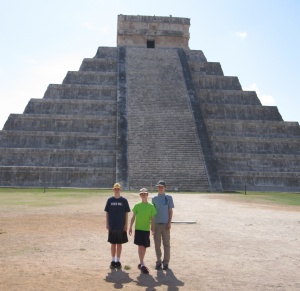The Values of Combining Digital Heritage
With an On-Site Visit
June 21, 2013
 Guest blogger: John Mooyman resides in Alamo, California and has completed his freshman year at Monte Vista High School. In his free time he enjoys scuba diving and exploring the outdoors. He is actively pursuing, and is close to his goal, of achieving Eagle Scout and enjoys building models in a club he founded.
Guest blogger: John Mooyman resides in Alamo, California and has completed his freshman year at Monte Vista High School. In his free time he enjoys scuba diving and exploring the outdoors. He is actively pursuing, and is close to his goal, of achieving Eagle Scout and enjoys building models in a club he founded.
My Spanish teacher introduced me to the Mayan culture and it piqued my interest to see them. My Dad introduced me to an organization called CyArk that creates 3D representations of world heritage sites, including Mayan. At the Commonwealth Club, the founder of CyArk, Ben Kacyra’s presentation further piqued my interest. Not long after, I convinced my parents to go on an adventure to Mexico to see Chichen Itza--the site highlighted by CyArk--and two other Mayan sites. The CyArk website became a great source of information to help plan our visit. Although using CyArk for our planning was beneficial, the real value came after the onsite visit where I was able to use the site to get additional insights and actually feel the full greatness of the rich history and amazing civilization.
The CyArk website features maps of Chichen Itza and digital photos from all angles of many of the ancient ruins. When I arrived, I was amazed at its size, but was disappointed that we could not climb to the top of the main temple. Seeing the digital images on the computer allowed me to experience it from all angles. The images also allowed me to see more than tourists are able to see. The virtual tour complimented and enhanced my physical experience.

CyArk perspective of El Castillo in the Great Plaza at Chichen Itza
A photo from the top of the pyramid allows you to virtually look down giving you a feel for how the Mayans viewed their civilization. I also gained more perspective by reading the descriptions CyArk includes for the different buildings that describe details about their origins and history. At the site itself, there were only brief explanations. The extra facts from CyArk allowed me to get a better idea of how the buildings were used and how the Mayans lived.

What the Mayans saw: CyArk photograph of the view from El Castillo's north staircase
The historical background and descriptive information on the CyArk site rounded out my experience and really prepared me for my visit. Chichen Itza is very well maintained, and thanks to CyArk this historical site has been digitally preserved forever.
After visiting Chichen Itza, I was interested in seeing as many ancient Mayan sites as possible. One, close by in Coba, allows visitors to explore yet another historical Mayan temple. This ancient ruin site permitted more interaction, allowing people to climb on the structures and bike the expansive grounds. I enjoyed that experience, but one could clearly see that it was being damaged by human impact.

Tourists climbing the Coba ruins (photo: Mooyman)
Although I was pleased that we were able to climb and cycle through the Coba ruins, the overall experience did not give me as much insight. There were little descriptions so I was not able to learn as much about its background and get a picture in my mind how the ancient Mayan community at Coba interacted. Many ruins are becoming overgrown by the jungle. Fortunately, groups like CyArk can record these moments in history, or they may be eventually lost forever.
The last ruin visit on our trip was in the town of Tulum. My first impression on arriving at the Tulum historical site was the overwhelming impact of commercialism which has taken over this landmark. Passing a Dairy Queen and seeing row after row of souvenir stands all selling the same junk really took away from the extraordinary ancient experience. This is yet one more example of why CyArk needs to record these sites in order to keep the history of these sites in perspective.
CyArk has given me more respect for my visit to Chichen Itza, Coba, and Tulum, as I know these places will not physically last forever. The value of combining digital heritage with an on-site visit has been very rewarding. CyArk is a tool for learning and its mission to preserve cultural heritage sites around the world will allow us to protect, explore and gain knowledge of our world’s history for many generations.

The author with his brothers on-site at Chichen Itza (photo: Mooyman)